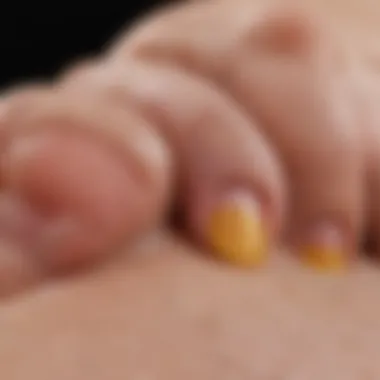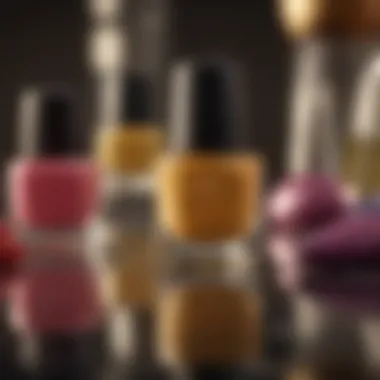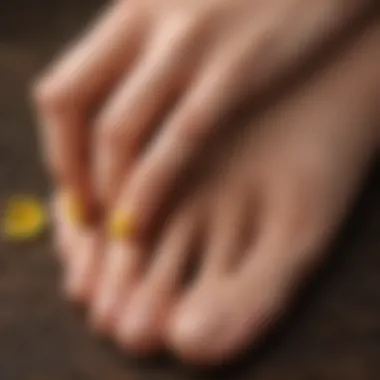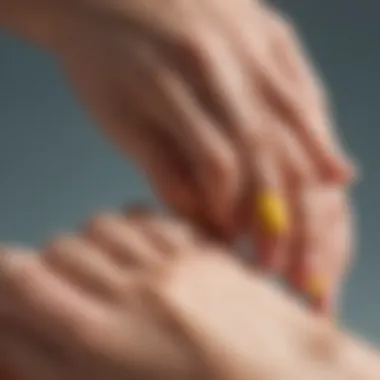How to Stop Yellow Toenails: Causes & Solutions


Intro
Yellow toenails can be a source of embarrassment for many individuals, affecting their confidence and self-esteem. Various factors contribute to this issue, ranging from fungal infections to the application of nail polish and even systemic health concerns. Understanding the underlying causes is crucial to finding effective solutions. In this article, we will explore the factors that lead to yellow toenails and offer actionable strategies to restore them to a healthy state.
Addressing yellow toenails is essential, not just for aesthetic reasons but also for overall foot health. Neglecting this issue can lead to more serious complications. Therefore, acquiring knowledge about prevention and treatment options is vital for maintaining beautiful and healthy toenails.
In the sections that follow, we will examine several aspects related to this topic, including prevention measures, effective treatments, and when to seek professional help. Let's begin by looking into the fashion aspects that can influence nail appearance.
Preamble to Yellow Toenails
Yellow toenails are more than just a cosmetic issue; they can signify underlying health problems and hygiene habits that need attention. Understanding the causes of yellow toenails is essential for anyone seeking to maintain foot health. This introduction outlines why toenail health is important, particularly for women, who often prioritize aesthetics alongside well-being.
Maintaining healthy toenails is crucial for overall foot hygiene. Neglecting them can lead to discomfort, avoidable infections, and, potentially, more serious health concerns. Notably, toenails can reflect an individual’s health, and discoloration can indicate issues such as fungi or systemic diseases.
Moreover, misconceptions surrounding yellow toenails can deter individuals from seeking necessary care. Misunderstandings related to nail health can be wide-ranging, influencing personal hygiene practices and even self-image. This article aims to debunk myths, clarify facts, and provide actionable solutions to ensure healthy and attractive toenails.
The Significance of Toenail Health
Healthy toenails serve multiple functions. They protect the sensitive tips of our toes, aid in balance, and contribute to our overall appearance. Poor toenail health, signified by yellowing, can often accompany discomfort, irritation, and embarrassment. This can lead to decreased physical activity, which is important for maintaining good health.
In addition to the aesthetic aspect, nails can also be an indicator of one’s overall health status. Changes in nail color, texture, or thickness can signal nutritional deficiencies or indicate illnesses such as diabetes or liver problems. Engaging in proactive care of toenails can help prevent conditions that might escalate.
Thus, understanding how to keep toenails healthy becomes not just a matter of beauty but also a vital part of personal health management. By focusing on toenail health, we empower ourselves to take greater charge of our well-being.
Common Misconceptions about Yellow Toenails
Several misconceptions surrounding yellow toenails can contribute to neglect in proper care.
- Misinterpretation of Symptoms: Many people often mistake yellow toenails for mere signs of aging or cosmetic neglect. In reality, these changes can indicate fungal infections or other health issues needing attention.
- Ignoring Treatment Options: Some believe that yellow toenails can only be fixed by cosmetic products like nail polish. While such products can mask the color, they fail to address the root cause.
- Attribution to Poor Hygiene: It is a common but incorrect assumption that yellow toenails are a direct result of poor hygiene. While hygiene plays a role, underlying health conditions often contribute significantly to this issue.
Addressing these misconceptions is vital for fostering healthier habits and ensuring prompt treatment when problems arise. Awareness and knowledge can lead to better outcomes and, ultimately, healthier toenails.
Identifying the Causes of Yellow Toenails
Understanding the causes of yellow toenails is essential for effective treatment and overall toenail health. Yellowing nails can indicate various underlying issues, ranging from harmless cosmetic problems to serious health concerns. Identifying these causes allows for targeted interventions and can lead to improved dental aesthetics and self-confidence.
Recognizing why toenails turn yellow can help in preventing recurrence. Each cause has its own specific characteristics and remedies. Understanding these can guide individuals in making informed choices about treatments and lifestyle adjustments.
Fungal Infections
Understanding Onychomycosis
Onychomycosis is a common fungal infection that affects the toenails. It usually results from fungi taking hold within the nail bed, leading to discoloration and thickening of the nail. This condition not only causes yellowing but can also lead to discomfort and further complications if left untreated. It is significant for this article because many readers may not be aware that this infection is widespread and often easily treatable.
A key characteristic of onychomycosis is its gradual onset, making it difficult to notice early changes. Early intervention can halt the progression and minimize visible symptoms.
Symptoms of Fungal Infections
Recognizing the symptoms of fungal infections is crucial. Common signs include yellow, brittle nails, and sometimes a foul odor. This condition can grow progressively worse, leading to significant discoloration. Knowing these signs can encourage timely action, which is important for both health and aesthetics.
The unique attribute of these symptoms is that they often impact one nail initially, but if untreated, can spread to others. Identifying fungal infections early assists in managing them effectively.


Nail Polish and Chemicals
The Impact of Frequent Use
Frequent application of nail polish can lead to yellow toenails due to staining from pigments and chemical reactions. Nail products may contain harsh chemicals that contribute to discoloration over time. This aspect plays a significant role in this article as many readers may not link their cosmetic choices to toenail health.
The key characteristic here is that regular exposure to these products can lead to cumulative damage, turning nails dull and yellow. Understanding this impact can promote healthier beauty routines.
Choosing the Right Products
Choosing the right nail polish and removers can minimize damage. Opting for those that are free of harmful chemicals can offer significant benefits. This includes nail products labeled as "3-free" or "5-free," indicating absence of toxic ingredients. The emphasis on selecting safer products puts control back in the reader's hands, enabling them to maintain nail health.
A unique feature of this choice is that it not only addresses the aesthetic aspect but also fosters long-term nail strength and health.
Underlying Health Conditions
Diabetes and Circulation Issues
Underlying health conditions such as diabetes can have a profound impact on toenail appearance. Poor circulation associated with diabetes can lead to yellowing of the nails. For this article, recognizing this connection is paramount since it opens discussions on health management and prevention.
The key characteristic of how these conditions affect nails is through restricted blood flow, which can also impede healing, making early detection crucial for effective management.
Nutritional Deficiencies
Nutritional deficiencies, particularly in vitamins like biotin or zinc, can also contribute to yellow nails. This topic is relevant to this article as it underscores the importance of a well-balanced diet.
A key feature of nutritional deficiencies is that they often manifest subtly before becoming severe. Identifying deficiencies early can prevent further nail damage and promote overall health. Incorporating a variety of nutrients can serve as both a preventive measure and a remedy for maintaining toenail health.
Injury and Trauma
The Role of Physical Damage
Physical damage to the toenails can also cause them to appear yellow. Trauma from improperly fitting shoes or sports injuries can lead to discoloration as the nail grows back. This aspect is important as many do not consider that physical trauma can be a contributor.
A key characteristic is that symptoms of trauma may not appear immediately. Understanding the delayed effects can assist individuals in recognizing when to seek treatment.
Identifying Symptoms of Trauma
Identifying the symptoms of trauma is essential for proper evaluation. Symptoms can include discoloration, swelling, or changes in texture. Knowledge of these signs helps in preventing further damage.
The unique aspect of identifying trauma early is that it often allows for simple interventions to prevent long-term issues, thus providing a straightforward pathway to maintaining toenail aesthetics.
Overall, identifying the causes of yellow toenails empowers individuals to take appropriate steps toward healthier nails. By focusing on these topics, this guide aims to enhance awareness and encourage proactive management of toenail health.
Preventative Measures for Healthy Toenails
Preventative measures are crucial in maintaining healthy toenails. Understanding the significance of these practices can reduce the risk of yellowing and other nail conditions. Maintaining proper toenail health not only enhances appearance but also prevents underlying issues from becoming more severe.
Proper Foot Hygiene
Cleaning and Drying Techniques


Proper cleaning and drying techniques play a vital role in foot health. Keeping toenails clean reduces the accumulation of dirt and bacteria that can lead to fungal infections. Regular washing with mild soap and water ensures nails are free from debris. It is essential to dry feet thoroughly, especially between the toes, to avoid moisture retention. This can limit the growth of pathogens. Adopting these techniques is a popular choice since it is simple and effectively reduces risk factors associated with yellow toenails.
Moisturizing to Prevent Cracking
Moisturizing is another important step to prevent nail cracking. Regular application of a foot cream helps in maintaining skin hydration, especially in dry conditions. Cracked skin can serve as an entry point for infections. Thus, keeping feet moisturized provides a barrier against harmful substances. This step may not be as widely recognized, but its importance cannot be understated.
Choosing the Right Footwear
Importance of Breathability
Selecting breathable footwear is essential in preventing yellow toenails. Shoes made from natural materials allow better airflow. This reduces heat and moisture buildup, creating a less favorable environment for fungal infections. From this perspective, breathable footwear is a beneficial choice, as it not only enhances comfort but also supports foot hygiene.
Avoiding Tight-Fitting Shoes
Avoiding tight-fitting shoes is equally crucial. These shoes can constrict circulation and pressure toenails, leading to discoloration. Choosing the right size and fit is a proactive measure, ensuring that toes have enough space. This practice helps maintain nail health and prevents painful conditions like ingrown toenails or deformities.
Diet and Nutrition
Essential Vitamins for Nail Health
Nutrition is often overlooked in discussions of toenail health. Essential vitamins, particularly Biotin and Vitamin E, are fundamental for maintaining nail strength and appearance. A diet rich in these vitamins can contribute positively to nail health. Incorporating foods such as eggs, nuts, and leafy greens can be highly effective.
Hydration and its Benefits
Staying hydrated is a factor that impacts overall nail health. Water aids in maintaining nail elasticity and promotes natural growth. Dehydration can lead to brittle nails, increasing the chance of injury and infection. Ensuring adequate fluid intake is a simple yet effective measure to enhance toenail condition.
Effective Treatment Options for Yellow Toenails
Understanding the treatment options for yellow toenails is crucial. These treatments aim to restore the natural color and health of toenails, enhancing overall foot aesthetics. Moreover, appropriate treatments address the underlying causes rather than simply masking the symptoms. This section covers various methods that range from accessible over-the-counter solutions to home remedies, along with insights on when to seek professional assistance.
Over-the-Counter Treatments
Over-the-counter treatments are often the first line of defense against yellow toenails. These are convenient options available at local pharmacies. Common treatment products include antifungal creams and lacquers specifically designed to fight infections caused by fungi.
Applying these treatments consistently can yield significant improvements. However, it's essential to follow the instructions carefully to ensure effectiveness. Be aware that results may take time. Patience in this process is vital.
Home Remedies to Consider
Home remedies can provide natural solutions that many people prefer over commercial products. These methods often utilize readily available ingredients. Natural substances can sometimes be gentler on toenails while still offering benefits.
The Role of Essential Oils
Essential oils are popular in home treatments for yellow toenails. The antibacterial and antifungal properties of oils like tea tree oil and lavender oil help in fighting infections. The appealing aspect of essential oils is their natural origin. They often come without harsh chemicals, making them suitable for many individuals, particularly those with sensitive skin. However, it's important to dilute them with a carrier oil to prevent irritation.
While essential oils may take longer to show results compared to over-the-counter options, their holistic approach makes them attractive for those seeking natural remedies. They can also provide refreshing scents and contribute to a soothing experience during application.
Natural Antifungal Solutions
Natural antifungal solutions, such as vinegar soaks or baking soda pastes, can be effective in treating yellow toenails. The characteristic of these solutions is their ability to combat fungal growth safely. Many people choose these treatments due to their simplicity and low cost. For instance, soaking affected toenails in a mixture of water and vinegar can help eliminate fungi.
Nonetheless, natural treatments often require consistent application and a longer time to be effective. It is important to note that the severity of the infection may dictate effectiveness. Evaluating improvement is necessary to decide if these methods suffice or if professional intervention is needed.


When to Seek Professional Help
Consulting a healthcare professional is important when at-home treatments fail. Recognizing when to seek assistance can prevent complications. Professional evaluations often lead to quicker recovery.
Identifying Severe Infections
Severe infections can be identified through symptoms such as persistent pain, extreme discoloration, and swelling. Monitoring these signs is essential. If such symptoms appear, it is advisable to get specialized advice. This proactive approach ensures that infections do not worsen while providing peace of mind.
Consulting a Dermatologist
Consulting a dermatologist is crucial for persistent yellow toenails. Dermatologists possess the expertise to diagnose the exact cause behind discoloration. They can offer targeted treatments, whether they may involve prescription medications or advanced therapies. Engaging with a dermatologist can save time and resources, improving outcomes faster than self-treatment methods.
Seeking professional help early can prevent complications and promote faster recovery.
The Psychological Impact of Yellow Toenails
Yellow toenails may seem like a superficial concern, but they can significantly influence a person’s psychological well-being. Many individuals associate nail health with overall self-care. When someone has yellow toenails, it can lead to feelings of embarrassment or insecurity, affecting self-esteem and, ultimately, their body image. Addressing these psychological aspects is crucial for a holistic approach to nail care and personal health.
Self-Esteem and Body Image
Self-esteem is often tied to physical appearance. For many women, toenails are a part of their identity and personal expression. A visible change, such as yellowing toenails, can induce negative thoughts and self-criticism. This phenomenon is particularly strong in contexts like summer, when open-toed shoes are more common. Having to hide one’s feet may lead to discomfort in social situations or at beaches, which can contribute to body image issues.
Research indicates that poor body image can lead to mental health challenges, including anxiety and depression. These feelings can create a vicious cycle; as self-esteem drops, individuals may neglect their personal care further, worsening the appearance of their toenails. Each of these factors may lead to a reluctance to engage in social activities or wearing certain clothing. It is thus paramount to recognize the psychological ramifications yellow toenails can bring and to actively seek solutions.
Consider these points for improving self-esteem:
- Invest in nail health: Understanding how to treat and prevent yellow toenails empowers individuals.
- Seek support: Engage with friends or communities for shared experiences and advice.
- Embrace self-care: Regular pampering can foster positive body image and improve confidence.
Addressing Stigma and Social Perceptions
The experience of having yellow toenails can also be compounded by societal stigma. People often form judgments about hygiene and health based on superficial appearances. This can lead to feelings of isolation or misunderstanding. Many cultures place high importance on grooming and appearance, which can create pressure to conform to certain beauty standards.
Acknowledging and challenging these social perceptions is vital. Education can play a key role in changing how people perceive conditions like yellow toenails. By normalizing discussions around toenail health, communities can reduce the stigma associated with personal foot care issues. Engaging in conversations about common causes, such as fungal infections or overuse of nail products, can foster a more inclusive environment where individuals feel less shame about their conditions.
"Understanding that yellow toenails are often a common issue can ease the burden of stigma, encouraging people to seek help freely."
To combat stigma effectively:
- Share stories: Personal experiences can help demystify toenail issues.
- Promote education: Raising awareness reduces misconceptions and fosters empathy.
- Advocate for acceptance: Fostering a culture of acceptance encourages open dialogues about personal care.
In summary, addressing the psychological impact of yellow toenails is essential. Women of all ages must understand that self-esteem and social perceptions can drastically influence their confidence. Taking proactive measures not only aids in improving toenail health but also enhances overall mental well-being.
Epilogue
In the realm of body care, the condition of one’s toenails often receives inadequate attention. However, yellow toenails can be a visible indicator of underlying issues that require both awareness and action. This article has outlined various causes of yellow toenails, from fungal infections to the effects of nail polish and potential health conditions. Understanding these causes is crucial as it allows individuals to take proactive steps in their nail care.
Regular maintenance and appropriate treatments can reverse discoloration and promote the health of toenails. Ongoing care helps to not only prevent yellowing but also contributes to overall foot health.
Recap of Key Points
- Fungal Infections: Identify symptoms like thickening and discoloration.
- Nail Polish and Chemicals: Consider limiting the use of harsh nail products.
- Underlying Health Conditions: Regular check-ups can catch health issues early.
- Preventative Measures: Establish a consistent foot hygiene routine.
- Treatment Options: Familiarize yourself with over-the-counter and natural remedies.
Encouragement for Ongoing Care
Maintaining healthy toenails is an ongoing process that involves diligence. It’s important to regularly assess nail health and make adjustments as necessary. Incorporate foot health into your routine—choose breathable shoes, practice good hygiene, and ensure proper nutrition.
Remember, prevention is more effective than treatment. By staying informed about the signs and causes of yellow toenails, you empower yourself to take action before issues escalate. Investing in your toenail health is not merely about aesthetics; it reflects self-care and awareness of overall well-being. Being proactive in maintaining toenail health enhances your confidence and quality of life.



